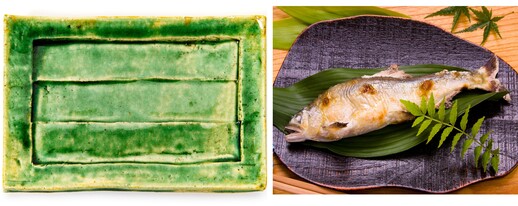2024.07.04
宙ちゃんの「伝統文化一直線」宙ちゃんの「伝統文化一直線」 第8回 丸くない食器
近藤宙時=日本伝統文化検定協会理事

日本独特の丸くない皿(左は織部焼)
鮎(あゆ)の塩焼きがおいしい時期になりましたが、鮎に限らず、焼き魚を食卓に出すと言うと、大抵の人は長方形の皿に盛り付けたものを思い浮かべるのではないでしょうか。
しかしながら、日本では当たり前の長方形の皿は、世界的に見るとかなり珍しい食器です。日本以外の国で丸い形以外の食器を見ることはまずありません。私が知っている限りでは、メキシコで魚形の皿が作られています。ただし、これは鑑賞用の土産品で、使われるとしてもせいぜいアクセサリー入れか何かで、食卓に乗ることはまずないと思います。
ところが日本では、焼き魚用の長方形の皿だけではなく、おひたしなどの向付に使う割れ山椒(サンショウの実が割れたような三つに裂けた形の小鉢)や菊形の銘々皿など、多くの家庭の食器棚に丸くない食器がごく普通に並んでいます。
どうして日本人だけが丸くない食器を使うのだろう。そんな疑問を抱いて縄文時代初期の隆帯文(りゅうたいもん)土器から歴史をたどると、豊臣、徳川と二つの政権で茶頭(さどう)を務めた古田織部(ふるた・おりべ)という戦国大名に行き当たります。彼がプロデュースした「織部焼」と称される茶碗は、それまでの常識を覆すものでした。何せ最初から形がゆがんでいるのですから。
古来、陶磁器職人は、いかに真円の食器を作れるかが腕の見せどころでした。そのための道具が轆轤(ろくろ)です。職人たちは轆轤をうまく使って真円の茶碗を作る修業を重ねました。ところが織部は、素焼き前のまだ粘土が柔らかいうちにグシャっと手でつぶしたような、真円とは程遠い茶碗を良しとしたのです。しかも、わざとらしくゆがめてはいけない。あたかも自然が生み出したような、作為の感じられないゆがみ方を求めました。これは実に革命的なことでした。
さらに織部は、ゆがんだ器に〇(丸)や□(四角)などの抽象的な図柄を描かせました。これによって、日本の食器は形からも図柄からも自由になったのだと思います。尾形光琳(こうりん)、乾山(けんざん)の兄弟は、織部が無作為の作為でねじ曲げたことで形の自由を得た食器を正方形や菊形、扇形などに美しく整え、そこに名画を描いてみせました。これで、日本の食器は世界で最も自由な食器になりました。
日本にしかない丸くない食器は、いずれ必ず世界を魅了するのではないかと夢見ています。そういう話をすると、「丸くない食器は海外では決して売れないよ、使わないんだから」と断言する人が少なくありません。靴を履かない未開社会の人たちを見て「靴は売れない」と諦めるのか、それとも「巨大な潜在需要がある」と心を躍らせるのか。その違いだとは思いますが、私自身は、世界中の人々が日本の丸くない食器を使う日が来るのを確信しています。
カテゴリー: 宙ちゃんの「伝統文化一直線」
関連タグ: #陶磁器





